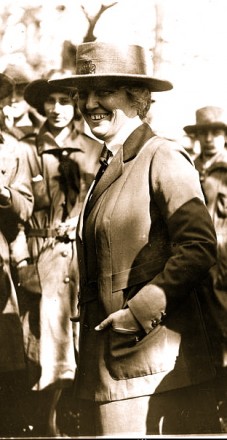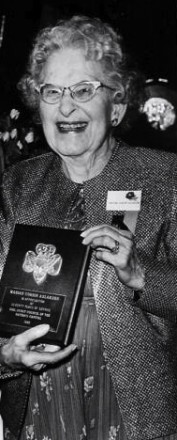Marian Corbin Aslakson knew Juliette Gordon Low. She was just a girl, but she was “at the right place and the right time,” when “Miss Daisy,” as Marian called her, returned to Savannah in 1912, zealous about spreading the new Girl Guiding movement that had begun so auspiciously in Great Britain. Marian Corbin was a student at the school operated by Juliette’s cousin Nina Pape. And when Juliette asked Nina for willing volunteers for the first Girl Guide troops in the United States, Marian stepped forward.
She remembered how Miss Daisy began by teaching all eighteen members of the White Rose Patrol the Girl Scout Promise and the Laws, and then she showed them how “to tie twelve knots, blaze a trail, light a fire with one match.” [1]
___________________
The twelve knots in the first Girl Scout Handbook:
1. Bowline
2. Running Bowline
3. Reef Knot
4. Clove Hitch
5. Half-Hitch
6. Fisherman’s Knot
7. Round Turn and Two Half-Hitches
8. Sheet Bend
9. Sheep-Shank
10. Middleman’s Knot
11. Slip Knot
12. Overhand Loop Knot [2]
___________________
Because Miss Daisy thought the girls ought to get some exercise–but that exercise should be fun–the earliest troops played basketball or tennis at each meeting. The girls also had to “be able to cook one dish.” [3]What did they cook? Peppermint drops!
___________________
Peppermint Drop recipe
Put three and a half ounces of sugar and a tablespoonful of water in a small granite saucepan, add three drops of essence of peppermint. Stand the saucepan over the fire, and, when the mixture begins to melt, stir with a small wooden paddle for two minutes, then take it from the fire. Have ready large sheets of oiled fool’s-cap paper. Take the saucepan in the left hand, and your candy dipper in the right. Pour the candy in drops about the size of large peas, in close rows on the oiled paper, using the handle of the candy dipper to cut off, as it were, each one from the saucepan. When the drops are firm and cold, dip a paste brush in warm water and lightly brush the under side of the paper, then with a limber knife remove the drops, and place them on a sieve in a warm place to dry. Keep in air-tight boxes.[4]
___________________
Marian stayed with Girl Scouting for many years. In 1922, she and the other members of the White Rose Patrol lined up in Miss Daisy’s Savannah home, right next to their Founder, to meet the new president of the Girl Scouts of the U.S.A., Lou Henry Hoover.
Years later, Marian told a Washington Post interviewer that “one thing the Girl Scouts did for me was to give me a terrific yen for traveling.” [5] She and her husband saw much of the world together. In the Philippines, in China, in Europe, wherever she went, Marian sought out Girl Scouts because she believed that once among Girl Scouts, “you’re never among strangers.” While living in Peru, she began a Girl Scout troop that consisted of American expatriates and Peruvian girls. Marian Aslakson also created a troop in Chevy Chase, Maryland, and consulted briefly with a troop in Bogata, Columbia. Her work continued when she returned to the Washington, D.C. area and took charge of the Juliette Low Memorial Fund. Its purpose was one she about deeply: to underwrite the travel of American girls to Our Chalet in Switzerland, “so,” as Marian explained, “they could get to know each other.” [6]
Marian Aslakson died in 1991 after a full seventy years of service to Girl Scouting. Her story can be found on the website of the Girl Scouts of the Nation’s Capital Archives Committee.
As an historian, I know how absent Girl Scouts and Girl Scouting are from the historical record–from textbooks, from films, even from novels. The more Girl Scout documents we can locate, preserve, store, digitize and put on line, and the more oral histories we collect, the greater the likelihood of all Americans understanding the full extent of what Girl Scouts have done for the U.S. and what Girl Scouting has done for girls and women. If you are a Girl Scout and need a project, consider seeking out former Girl Scouts in your area to record their stories. Whether or not you’ve ever been a Girl Scout, think about volunteering with the History and Archives section of your local Girl Scout Council. You can find your local council by clicking here. Help enrich our nation’s history! Make a difference!
[1] Andee Hochman, “Pioneer Scout Shares Lessons,” Washington Post, n.d.; Marian Aslakson, “An Address on Girl Scouting, “ 7 April 1973,” 2, both from Girl Scouts of the Nation’s Capital History Archives, http://www.gscnchistoryarchives.org/files/Marian_Corbin_Aslakson.pdf.
[2] Juliette Gordon Low and W. J. Hoxie, How Girls Can Help Their Country (New York: Knickerbocker Press, 1913), 30-32.
[3] Hochman.
[4] Sarah Tyson Hester Rorer, Home Candy Making (Philadelphia: Arnold & Company, 1889), 51-52. This book was reprinted many times and was a staple in American kitchens.
[5] Hochman.
[6] Aslakson, “An Address on Girl Scouting,” 5-6. The quote can be found on page 6. In her address, Aslakson claims that she changed the name to the World Friendship Fund.
Photo of Mrs. Aslakson from http://archivesprojects.homestead.com/HerStories/HerStoriesProjectAslakson.html. Photo of Mrs. Hoover from the Library of Congress.



